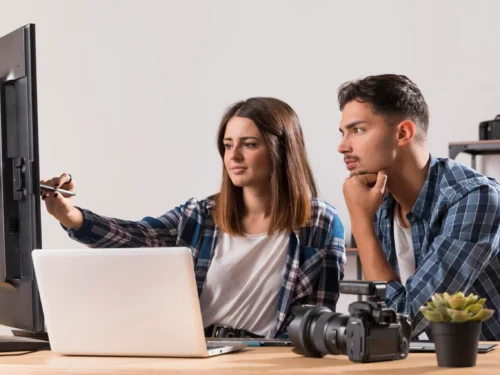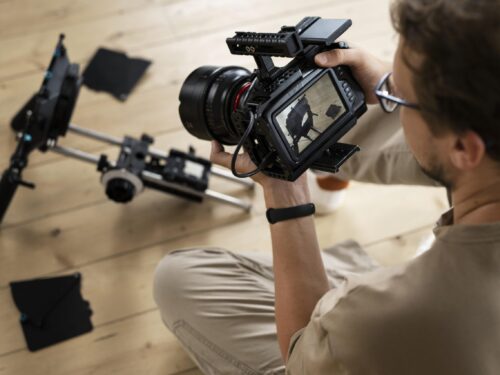The Art Of Video Editing
If you think video editing is as simple as cutting and pasting together something on a timeline, then you’d be correct. After all, social media videos don’t need too much leg work. All you need to do is film a short clip or two, cut them together, add a filter and some text, and you’re done. But professional video editing, especially for feature films, commercial videos, and corporate videos need so much more. There is an art to video editing, and as a similar article on MusicBed (2021) poetically describes “Editors are surgeons, storytellers, and mad scientists who somehow manage to bring disparate hunks of material to life. They wield a scalpel in one hand, and a butcher’s cleaver in the other”. So, here are a few reasons professional video editors are artists.Cut On Action
When creating a video, especially one that involves movement, like walking down the street, a kiss, a fight, or even someone raising a glass, you should cut on action. What this means is, say, for example, you’re editing a fight scene, you wouldn’t watch the whole thing with a wide shot. It makes it less interesting, and you don’t get the nuanced details of the fight, like blood dripping from a character’s nose. Instead, what you’d do is cut the shots, so you get many different angles of the action to make it more exciting and fast-paced. After all, in a real fight, everything happens in a blur and is too quick to remember, right? The same goes for editing the scene. So, if one of the actors is about to throw a punch, cut from the wide shot to a close-up of his fist connecting with the other person. In another situation, say for example a wedding video and you’re watching the bride and her bouquet toss, you would cut the action, when the bouquet is up in the air, and when it’s caught by one of the guests. By cutting on action, you’re drawing interest and emotion into the scene, and adding pace to the action. It is a good technique that many editors use, especially if the video they’re editing is a fictional story.
Find Out How We Can Turn Your Footaged Into A Masterpiece
Unlimited Revisions – Whatever changes are needed, send them through and we will Fix them.
Fast Turnaround Time – We are always available to meet the tightest of deadlines when necessary.
Risk-Free Trial – Send your first video editing project to us and if you are not 100% happy with the results we produce, you don’t pay!
Use Match Cuts
What are match cuts? They’re a transition technique that makes a film move seamlessly from one scene to another. If you’ve watched a film that included a backstory of a character, you’ll see that a particular action the character makes is repeated in both scenes. For example, when the younger character shuts their eyes and opens them again, they’re older, or they’re in a different place. This is what a match cut is. It connects both scenes, not only through the transition but in emotion as well. It gives the audience context for what is about to happen next.
When using match cuts, be careful how you use them. Sometimes they can be obvious, especially if the scenes are in completely different locations, at different times of the day and need different lighting. It can be mistaken for a regular cut rather than a match cut and can ruin the aesthetic you’re going for. That’s why it’s artistic. It creates an emotional attachment that can be felt throughout the film or video. It has given rise to modern transition techniques that combine match cuts with cinematographic effects, like trombone zooms, fast panning and tilting or various tracking shots.

Colour Grading
Other than transitions and cuts, one of the best ways to show off their creative skills, film editors rely on colour grading. What this means is that when they’re given a piece of footage, video editors will play around with the colours of the video. That doesn’t mean they’ll change the colour completely unless that’s what the director and producers want.
When a film is shot, different lighting setups, angles and locations can change from shot to shot, changing the way the shot looks on screen. It is the editor’s job to fix that, so that the scene looks consistent, and not as if it was shot over three days, or as if the director has included reshoots after completing the initial shoot.
For example, if the film crew shot at a beach, at sunset, they only have a few hours to capture what should be a five-minute scene, but they need to capture multiple shots of different angles, so they will have to shoot over three or four days. And because the sun waits for no one, the light from the sun and the artificial light the crew might add will change the way each shot looks from one another. One shot will be brighter than the other, or one shot will be darker.
It is the editor’s responsibility to make sure that each shot matches each other. So, they need to play around with the exposure, the brightness, the contrast, and yes, even the colour of the film, to make it look like it didn’t take the cast and crew three days to shoot. Of course, that’s not to say that perception isn’t involved. If an editor loves the use of saturated colour in their films, then a film can be very bright and colourful, or if the film is part of a more sombre and emotionally charged genre, they can dim the saturation, so only the barest hint of colour can show. Essentially, colour grading is the realm of video editing that a video editor has free reign, with the permission of the director, of course.
It’s Complicated But We Can Handle It
So, with video editing software becoming more accessible and easier to use, thanks to TikTok and social media, and because both PCs and Macs provide free video editing software, you can start to play around with creating your own videos and editing them. But, if you’d like to have something more professional, one that doesn’t look like it’s been made by an amateur, trust a professional who understand the art of editing.
We at Cut Pro Media have professionals who can handle the software and the intricate functions that the general public won’t have access to, because they wouldn’t know where to find it. With backgrounds in filmmaking and video editing, our professionals will know where to look, and what to do, when editing videos. So, you don’t have to do the research, or experiment through trial and error, to get the right look and feel for your videos. Our professionals can do that for you, and more. All they need to know is what you’d like.
Bibliography
MusicBed, (n.d.), Frames Matter: The Art And Craft Of Editing, [Online], Available at: https://musicbed.com/blog/filmmaking/editing/frames-matter-the-art-and-craft-of-editing [Accessed April 22, 2021]










